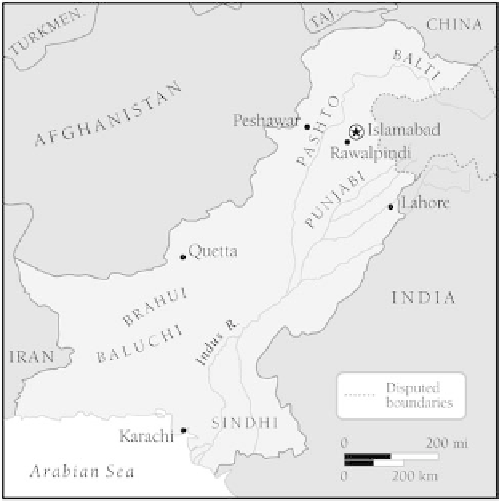Geography Reference
In-Depth Information
The question of Islam' s role in government remains
a critical aspect of political instability in Pakistan. In
1956, under pressure from conservative Islamists, the
government declared Pakistan an Islamic Republic.
Government was to operate according to the Quran and
sunna
, the words of Muhammed. Religious moderates,
who had pushed for modernization and democracy ,
were sidelined.
Other problems centered on the rich-poor gap and
other real and perceived inequities. After partition, many
business-class Punjabis moved to Karachi' s Sind
Province, where they took over former Hindu businesses
and came to dominate the economy . Added to the fray
were the
Muhajirs
, Muslims who had previously lived in
India. The urban-dwelling, Urdu-speaking Muhajirs,
many of whom were educated and experienced in busi-
ness and civil service, came to dominate administration.
However, these Punjabi and Muhajir urban elites were
resented by the Sindis. As the government struggled to
establish some degree of equity under the weight of
vested interests and expected patronage, the rich-poor
and urban-rural gaps widened. Urban riots and peasant
revolts led to the imposition of martial law in 1958.
With ensuing economic and political instability , East
Pakistan looked to a new political party—the Awami
League led by
Mujibur Rahman (Mujib)
. Mujib would
fight for greater political autonomy for the east. The fol-
lowing years of hectic east-west relations served to
strengthen the resolve of the Awami League.
In 1965, Pakistan went to war with India over border
demarcation in the Rann of Kutch as well as in Kashmir.
The year-long war was costly . Since both border disputes
were with West Pakistan, East Pakistan felt unduly bur-
dened. More disturbances again drew military rule,
which lasted until 1970 when elections were to be held.
In Karachi, the Pakistan' s People' s Party (PPP), un-
der the leadership of Zulfikar Ali Bhutto, ran on the slo-
gan “Islam our Faith, Democracy our Polity , Socialism
our Economy .'' Bhutto also declared a “thousand years''
war with India.
Elections were delayed because of a crippling cy-
clone in East Pakistan. Then, entirely dissatisfied with
West Pakistan' s relief efforts, the Bengalis swept the
Awami League to victory , a pivotal event because the pro-
posed system of “one person one vote'' would give the
more populous east a majority in the National Assembly .
As it became clear that Mujib rather than Bhutto might
rule Pakistan, the National Assembly was “postponed''
by the military .
Figure 7-2
Major languages of Pakistan.
Since language is the context for thought and
action, and conceptualizations in one language do
not necessarily exist in another, differences can act
as centrifugal or divisive forces in any centripetal
drive for national cohesion.
Divisions sharpened with the economic and political
policies pursued by the government in West Pakistan.
There were arguments over exploitation of natural re-
sources, industrial development, acquisition and alloca-
tion of monetary resources, communal and regional
representation, and the role of Islam in government.
Although both parts of Pakistan were essentially
Muslim, there were differences in practice. A history of
communal strife marred the relationship between Mus-
lims, Hindus, and Sikhs in the west. Moreover, some eth-
nic groups (e.g., the Pathans) were extremely fervent in
their application of the mores and laws of Islam in their
daily lives. For Bengalis, religious interaction with Hin-
dus had become routine. They attended each other' s fes-
tivals and reciprocated in temple offerings.




















Search WWH ::

Custom Search